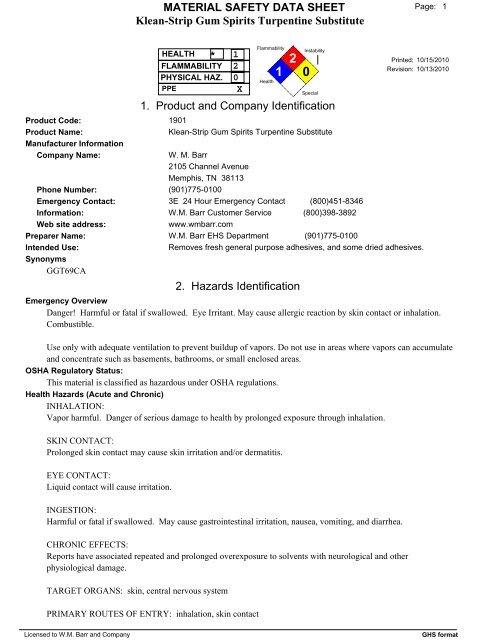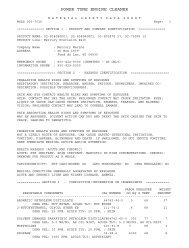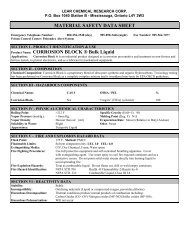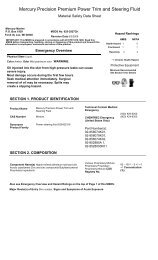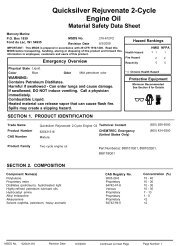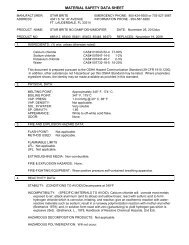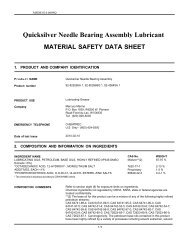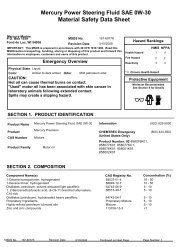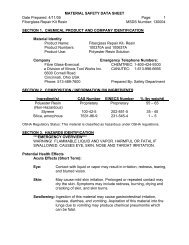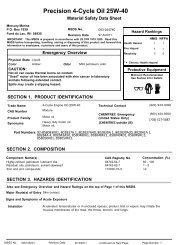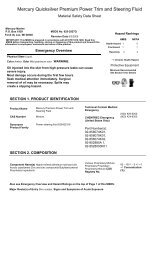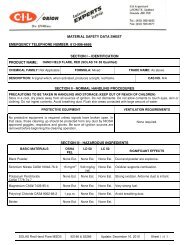Klean-Strip Gum Spirits Turpentine Substitute MATERIAL SAFETY ...
Klean-Strip Gum Spirits Turpentine Substitute MATERIAL SAFETY ...
Klean-Strip Gum Spirits Turpentine Substitute MATERIAL SAFETY ...
Create successful ePaper yourself
Turn your PDF publications into a flip-book with our unique Google optimized e-Paper software.
<strong>MATERIAL</strong> <strong>SAFETY</strong> DATA SHEET<br />
<strong>Klean</strong>-<strong>Strip</strong> <strong>Gum</strong> <strong>Spirits</strong> <strong>Turpentine</strong> <strong>Substitute</strong><br />
Page:<br />
1<br />
Product Code:<br />
Product Name:<br />
Manufacturer Information<br />
Company Name:<br />
Phone Number:<br />
Emergency Contact:<br />
Information:<br />
Web site address:<br />
Preparer Name:<br />
Intended Use:<br />
Synonyms<br />
GGT69CA<br />
HEALTH * 1<br />
FLAMMABILITY 2<br />
PHYSICAL HAZ. 0<br />
PPE<br />
X<br />
Flammability<br />
Health<br />
1<br />
2<br />
Instability<br />
0<br />
Special<br />
1. Product and Company Identification<br />
1901<br />
<strong>Klean</strong>-<strong>Strip</strong> <strong>Gum</strong> <strong>Spirits</strong> <strong>Turpentine</strong> <strong>Substitute</strong><br />
Printed: 10/15/2010<br />
Revision: 10/13/2010<br />
W. M. Barr<br />
2105 Channel Avenue<br />
Memphis, TN 38113<br />
(901)775-0100<br />
3E 24 Hour Emergency Contact (800)451-8346<br />
W.M. Barr Customer Service (800)398-3892<br />
www.wmbarr.com<br />
W.M. Barr EHS Department (901)775-0100<br />
Removes fresh general purpose adhesives, and some dried adhesives.<br />
2. Hazards Identification<br />
Emergency Overview<br />
Danger! Harmful or fatal if swallowed. Eye Irritant. May cause allergic reaction by skin contact or inhalation.<br />
Combustible.<br />
Use only with adequate ventilation to prevent buildup of vapors. Do not use in areas where vapors can accumulate<br />
and concentrate such as basements, bathrooms, or small enclosed areas.<br />
OSHA Regulatory Status:<br />
This material is classified as hazardous under OSHA regulations.<br />
Health Hazards (Acute and Chronic)<br />
INHALATION:<br />
Vapor harmful. Danger of serious damage to health by prolonged exposure through inhalation.<br />
SKIN CONTACT:<br />
Prolonged skin contact may cause skin irritation and/or dermatitis.<br />
EYE CONTACT:<br />
Liquid contact will cause irritation.<br />
INGESTION:<br />
Harmful or fatal if swallowed. May cause gastrointestinal irritation, nausea, vomiting, and diarrhea.<br />
CHRONIC EFFECTS:<br />
Reports have associated repeated and prolonged overexposure to solvents with neurological and other<br />
physiological damage.<br />
TARGET ORGANS: skin, central nervous system<br />
PRIMARY ROUTES OF ENTRY: inhalation, skin contact<br />
Licensed to W.M. Barr and Company<br />
GHS format
<strong>MATERIAL</strong> <strong>SAFETY</strong> DATA SHEET<br />
<strong>Klean</strong>-<strong>Strip</strong> <strong>Gum</strong> <strong>Spirits</strong> <strong>Turpentine</strong> <strong>Substitute</strong><br />
Page: 2<br />
Printed: 10/15/2010<br />
Revision: 10/13/2010<br />
Signs and Symptoms Of Exposure<br />
See Potential Health Effects.<br />
Medical Conditions Generally Aggravated By Exposure<br />
None known.<br />
3. Composition/Information on Ingredients<br />
Hazardous Components (Chemical Name)<br />
CAS # Concentration<br />
1. Hydrotreated light distillate (petroleum) 64742-47-8 60.0 -100.0 %<br />
2. <strong>Turpentine</strong> {<strong>Gum</strong>spirits; Supfate wood<br />
turpentine}<br />
8006-64-2 10.0 -30.0 %<br />
4. First Aid Measures<br />
Emergency and First Aid Procedures<br />
Skin:<br />
Wash the skin thoroughly with water and soap, if available, while removing contaminated clothing. Seek medical<br />
attention if irritation persists.<br />
Eyes:<br />
Immediately begin to flush eyes with water, remove any contact lens. Continue to flush the eyes for at least 15<br />
minutes. Seek medical attention.<br />
Inhalation:<br />
Remove to fresh air. If not breathing, give artificial respiration. If breathing is difficult, give oxygen. Get<br />
immediate medical attention.<br />
Ingestion:<br />
If swallowed, do NOT induce vomiting. Seek immediate medical attention. Call a physician, hospital emergency<br />
room, or poison control center immediately. Never give anything by mouth to an unconscious person.<br />
5. Fire Fighting Measures<br />
Flammability Classification: NFPA Class II<br />
Flash Pt:<br />
128.00 F Method Used: Setaflash Closed Cup (Rapid Setaflash)<br />
Explosive Limits:<br />
LEL: No data.<br />
UEL: No data.<br />
Special Fire Fighting Procedures<br />
Self-contained respiratory protection should be provided for fire fighters fighting fires in buildings or confined<br />
areas. Storage containers exposed to fire should be kept cool with water spray to prevent pressure build-up. Stay<br />
away from heads of containers that have been exposed to intense heat or flame.<br />
Unusual Fire and Explosion Hazards<br />
Material may float on water.<br />
Hazardous Combustion Products<br />
Carbon monoxide, carbon dioxide<br />
Suitable Extinguishing Media<br />
Use carbon dioxide, dry powder, foam, or water spray / fog.<br />
Unsuitable Extinguishing Media<br />
None known.<br />
6. Accidental Release Measures<br />
Steps To Be Taken In Case Material Is Released Or Spilled<br />
Vapors may cause flash fire or ignite explosively.<br />
Clean up: Keep unnecessary people away; isolate hazard area and deny entry. Stay upwind, out of low areas, and<br />
ventilate closed spaces before entering. Shut off ignition sources; keep flares, smoking or flames out of hazard<br />
Licensed to W.M. Barr and Company<br />
GHS format
<strong>MATERIAL</strong> <strong>SAFETY</strong> DATA SHEET<br />
<strong>Klean</strong>-<strong>Strip</strong> <strong>Gum</strong> <strong>Spirits</strong> <strong>Turpentine</strong> <strong>Substitute</strong><br />
Page: 3<br />
Printed: 10/15/2010<br />
Revision: 10/13/2010<br />
area. Use non-sparking tools. Use proper bonding and grounding methods for all equipment and processes. Keep<br />
out of waterways and bodies of water. Be cautious of vapors collecting in small enclosed spaces, sewers, low<br />
lying areas, confined spaces, etc.<br />
Small spills: Take up with sand, earth or other noncombustible absorbent material and place in a plastic container<br />
where applicable.<br />
Large spills: Dike far ahead of spill for later disposal.<br />
Waste Disposal: Dispose in accordance with applicable local, state and federal regulations.<br />
7. Handling and Storage<br />
Precautions To Be Taken in Handling<br />
Read carefully all cautions and directions on product label before use. Since empty container retains residue,<br />
follow all label warnings even after container is empty. Dispose of empty container according to all regulations.<br />
Do not reuse this container.<br />
Do not use this product near any source of heat or open flame, furnace areas, pilot lights, stoves, etc.<br />
Do not use in small enclosed spaces, such as basements and bathrooms. Vapors can accumulate and explode if<br />
ignited.<br />
Do not spread this product over large surface areas because fire and health safety risks will increase dramatically.<br />
Precautions To Be Taken in Storing<br />
Keep container tightly closed when not in use. Store in a cool, dry place. Do not store near any source of heat or<br />
open flame, furnace areas, pilot lights, stoves, etc.<br />
8. Exposure Controls/Personal Protection<br />
Hazardous Components (Chemical Name)<br />
CAS # OSHA PEL ACGIH TLV<br />
Other Limits<br />
1. Hydrotreated light distillate (petroleum) 64742-47-8 No data.<br />
200 mg/m3<br />
No data.<br />
2. <strong>Turpentine</strong> {<strong>Gum</strong>spirits; Supfate wood<br />
turpentine}<br />
8006-64-2 100 ppm 20 ppm<br />
No data.<br />
Respiratory Equipment (Specify Type)<br />
For use in areas with inadequate ventilation or fresh air, wear a properly maintained and properly fitted NIOSH<br />
approved respirator for organic solvent vapors.<br />
For OSHA controlled work places and other regular users - Use only with adequate ventilation under engineered<br />
air control systems designed to prevent exceeding the appropriate TLV.<br />
A dust mask does not provide protection against vapors.<br />
Eye Protection<br />
Chemical splash goggles should be worn to prevent eye contact.<br />
Protective Gloves<br />
Wear gloves with as much resistance to the chemical ingredients as possible. Glove materials such as nitrile<br />
rubber may provide protection. Glove selection should be based on chemicals being used and conditions of use.<br />
Consult your glove supplier for additional information. Gloves contaminated with product should be discarded<br />
and not reused.<br />
Licensed to W.M. Barr and Company<br />
GHS format
<strong>MATERIAL</strong> <strong>SAFETY</strong> DATA SHEET<br />
<strong>Klean</strong>-<strong>Strip</strong> <strong>Gum</strong> <strong>Spirits</strong> <strong>Turpentine</strong> <strong>Substitute</strong><br />
Page: 4<br />
Printed: 10/15/2010<br />
Revision: 10/13/2010<br />
Other Protective Clothing<br />
Various application methods can dictate use of additional protective safety equipment, such as impermeable<br />
aprons, etc., to minimize exposure. Before reuse, thoroughly clean any clothing or protective equipment that has<br />
been contaminated by prior use. Discard any clothing or other protective equipment that cannot be<br />
decontaminated, such as gloves or shoes.<br />
Ventilation<br />
Use process enclosures, local exhaust ventilation, or other engineering controls to control airborne levels below<br />
recommended exposure limits.<br />
Use only with adequate ventilation to prevent buildup of vapors. Do not use in areas where vapors can accumulate<br />
and concentrate, such as basements, bathrooms or small enclosed areas. Whenever possible, use outdoors in an<br />
open air area. If using indoors open all windows and doors and maintain a cross ventilation of moving fresh air<br />
across the work area. If strong odor is noticed or you experience slight dizziness, headache, nausea or<br />
eye-watering -- STOP -- ventilation is inadequate. Leave area immediately and move to fresh air.<br />
Work/Hygienic/Maintenance Practices<br />
Wash hands thoroughly after use and before eating, drinking, or smoking.<br />
Do not eat, drink, or smoke in the work area.<br />
Facilities storing or handling this material should be equipped with an emergency eyewash and safety shower.<br />
Physical States:<br />
Melting Point:<br />
Boiling Point:<br />
Autoignition Pt:<br />
Flash Pt:<br />
Explosive Limits:<br />
Specific Gravity (Water = 1):<br />
Density:<br />
Bulk density:<br />
Vapor Pressure (vs. Air or mm Hg):<br />
Vapor Density (vs. Air = 1):<br />
Evaporation Rate (vs Butyl<br />
Acetate=1):<br />
Solubility in Water:<br />
Percent Volatile:<br />
VOC / Volume:<br />
Viscosity:<br />
Heat Value:<br />
Particle Size:<br />
Corrosion Rate:<br />
9. Physical and Chemical Properties<br />
Not Soluble<br />
100.0 % by weight.<br />
166.0000 G/L<br />
water thin<br />
No data.<br />
No data.<br />
No data.<br />
pH:<br />
No data.<br />
Appearance and Odor<br />
Aromatic hydrocarbon-like odor. Clear liquid, water white.<br />
[ ] Gas [ X ] Liquid [ ] Solid<br />
No data.<br />
No data.<br />
No data.<br />
128.00 F Method Used: Setaflash Closed Cup (Rapid Setaflash)<br />
LEL: No data.<br />
UEL: No data.<br />
0.824<br />
6.91 READ CA<br />
No data.<br />
No data.<br />
> 1<br />
> 1<br />
Licensed to W.M. Barr and Company<br />
GHS format
<strong>MATERIAL</strong> <strong>SAFETY</strong> DATA SHEET<br />
<strong>Klean</strong>-<strong>Strip</strong> <strong>Gum</strong> <strong>Spirits</strong> <strong>Turpentine</strong> <strong>Substitute</strong><br />
Page: 5<br />
Printed: 10/15/2010<br />
Revision: 10/13/2010<br />
Additional Physical Information<br />
This product contains 20% by weight VOC as defined by the California Air Resources Board (CARB).<br />
10. Stability and Reactivity<br />
Stability:<br />
Conditions To Avoid - Instability<br />
No data available.<br />
Incompatibility - Materials To Avoid<br />
Unstable [ ] Stable [ X ]<br />
Incompatible with acids, bases, and oxidizing agents.<br />
Hazardous Decomposition Or Byproducts<br />
Thermal decomposition may produce carbon monoxide and carbon dioxide.<br />
Possibility of Hazardous Reactions: Will occur [ ] Will not occur [ X ]<br />
Conditions To Avoid - Hazardous Reactions<br />
No data available.<br />
11. Toxicological Information<br />
This product has not been tested as a whole. Information below will be for individual ingredients.<br />
HYDROTREATED LIGHT DISTILLATES:<br />
ACUTE TOXICITY:<br />
LC50 Rat Inhalation >3,000 mg/kg<br />
LD50 Rabbit skin 5.5 mg/l 8 hrs<br />
SKIN CORROSION / IRRITATION: Studies on laboratory animals have shown similar materials to cause skin<br />
irritation after repeated or prolonged contact. Repeated direct application to the skin can produce defatting<br />
dermatitis and kidney damage in laboratory animals. The significance of these animal study results to human<br />
health is unclear.<br />
SERIOUS EYE DAMAGE / IRRITATION: Studies on laboratory animals have associated similar materials with<br />
eye and respiratory tract irritation.<br />
RESPIRATORY OR SKIN SENSITIZATION: Skin sensitization was not evident in animal studies.<br />
ASPIRATION HAZARD: This material presents an aspiration hazard.<br />
MUTAGENIC DATA: No data.<br />
IMMUNOTOXICITY: No data.<br />
NEUROTOXICITY: Repeated exposure to elevated concentrations of hydrocarbon solvents can produce a<br />
variety of transient CNS effects (e.g., dizziness, headache, narcosis, etc.)<br />
DEVELOPMENTAL/REPRODUCTIVE: No data.<br />
CARCINOGEN STATUS: There is inadequate evidence for the carcinogenicity of petroleum solvents in<br />
humans.<br />
------------------------------------------------<br />
TURPENTINE :<br />
ACUTE TOXICITY:<br />
LC50 Rat inhalation 3590 ppm/1 hr<br />
LD50 Rat oral 5760 mg/kg<br />
SKIN CORROSION / IRRITATION: Can cause dermatitis or chemical burns; it /can/ penetrate the skin to cause<br />
systemic effects.<br />
SERIOUS EYE DAMAGE / IRRITATION: Overexposure to turpentine may cause irritation to the eyes, nose,<br />
throat, and lungs.<br />
RESPIRATORY OR SKIN SENSITIZATION: Contact with turpentine oils can cause an allergic reaction.<br />
ASPIRATION HAZARD: Material is an aspiration hazard.<br />
MUTAGENIC DATA: no data<br />
Licensed to W.M. Barr and Company<br />
GHS format
<strong>MATERIAL</strong> <strong>SAFETY</strong> DATA SHEET<br />
<strong>Klean</strong>-<strong>Strip</strong> <strong>Gum</strong> <strong>Spirits</strong> <strong>Turpentine</strong> <strong>Substitute</strong><br />
Page: 6<br />
Printed: 10/15/2010<br />
Revision: 10/13/2010<br />
IMMUNOTOXICITY: no data<br />
NEUROTOXICITY: no data<br />
DEVELOPMENTAL/REPRODUCTIVE: There is limited evidence that <strong>Turpentine</strong> may damage the<br />
developing fetus.<br />
CARCINOGEN STATUS: Not classifiable as a human carcinogen.<br />
Chronic Toxicological Effects<br />
This product has not been tested as a whole.<br />
Carcinogenicity/Other Information<br />
ACGIH A4 - Not Classifiable as a Human Carcinogen.<br />
Hazardous Components (Chemical Name)<br />
CAS # NTP IARC ACGIH OSHA<br />
1. Hydrotreated light distillate (petroleum) 64742-47-8 n.a.<br />
n.a.<br />
A4<br />
n.a.<br />
2. <strong>Turpentine</strong> {<strong>Gum</strong>spirits; Supfate wood<br />
turpentine}<br />
8006-64-2 n.a.<br />
n.a.<br />
A4<br />
n.a.<br />
12. Ecological Information<br />
This product has not been tested as a whole. Information below will be for individual ingredients.<br />
Hydrotreated Light Distillates:<br />
Toxicity: Not toxic to aquatic organisms up to water solubility. May adsorb to sediments and possibly cause<br />
toxic effects to organisms.<br />
Persistence and Degradability: Slightly biodegradable in water-based tests due to low water solubility.<br />
Bioaccumulative Potential: No data.<br />
Mobility in Soil: No data.<br />
-------------------------------------------------------------<br />
TURPENTINE:<br />
Toxicity: This substance is immiscible with water. This substance is known to evaporate quickly and biodegrade<br />
and should not cause long term effects.<br />
Persistence and Degradability: This substance is known to evaporate quickly and biodegrade and should not<br />
cause long term effects. Related chemicals are known to be biodegradable.<br />
Bioaccumulative Potential: Not determined. Related chemicals are known to be non-accumulating in the<br />
environment.<br />
Mobility in Soil: No data.<br />
13. Disposal Considerations<br />
Waste Disposal Method<br />
Dispose in accordance with applicable local, state, and federal regulations.<br />
LAND TRANSPORT (US DOT)<br />
DOT Proper Shipping Name<br />
DOT Hazard Class:<br />
DOT Hazard Label:<br />
UN/NA Number:<br />
14. Transport Information<br />
<strong>Turpentine</strong>, solution<br />
3<br />
FLAMMABLE LIQUID<br />
UN1299<br />
Licensed to W.M. Barr and Company<br />
GHS format
<strong>MATERIAL</strong> <strong>SAFETY</strong> DATA SHEET<br />
<strong>Klean</strong>-<strong>Strip</strong> <strong>Gum</strong> <strong>Spirits</strong> <strong>Turpentine</strong> <strong>Substitute</strong><br />
Page: 7<br />
Printed: 10/15/2010<br />
Revision: 10/13/2010<br />
Packing Group:<br />
III<br />
Additional Transport Information<br />
For D.O.T. information, contact W.M. Barr Technical Services at 1-800-398-3892.<br />
The shipper / supplier may apply one of the following exceptions: Combustible Liquid, Consumer Commodity,<br />
Limited Quantity, Viscous Liquid, Does Not Sustain Combustion, or others, as allowed under 49CFR Hazmat<br />
Regulations. Please consult 49CFR Subchapter C to ensure that subsequent shipments comply with these<br />
exceptions.<br />
US EPA SARA Title III<br />
15. Regulatory Information<br />
Hazardous Components (Chemical Name)<br />
CAS # Sec.302 (EHS) Sec.304 RQ Sec.313 (TRI) Sec.110<br />
1. Hydrotreated light distillate (petroleum) 64742-47-8 No<br />
No<br />
No<br />
No<br />
2. <strong>Turpentine</strong> {<strong>Gum</strong>spirits; Supfate wood<br />
turpentine}<br />
8006-64-2 No<br />
No<br />
No<br />
No<br />
US EPA CAA, CWA, TSCA<br />
Hazardous Components (Chemical Name)<br />
CAS # EPA CAA EPA CWA NPDES EPA TSCA CA PROP 65<br />
1. Hydrotreated light distillate (petroleum) 64742-47-8 HAP, ODC () No<br />
Inventory<br />
No<br />
2. <strong>Turpentine</strong> {<strong>Gum</strong>spirits; Supfate wood<br />
turpentine}<br />
8006-64-2 HAP, ODC () No<br />
Inventory<br />
No<br />
EPA Hazard Categories:<br />
This material meets the EPA 'Hazard Categories' defined for SARA Title III Sections 311/312 as indicated:<br />
[X] Yes [ ] No Acute (immediate) Health Hazard<br />
[X] Yes [ ] No Chronic (delayed) Health Hazard<br />
[X] Yes [ ] No Fire Hazard<br />
[ ] Yes [X] No Sudden Release of Pressure Hazard<br />
[ ] Yes [X] No Reactive Hazard<br />
16. Other Information<br />
No data available.<br />
Licensed to W.M. Barr and Company<br />
GHS format


